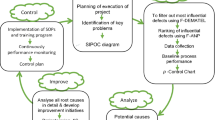Abstract
Twelve-inch wafer slicing is the most challenging process in semiconductor manufacturing yield. This study applies the fuzzy analytic hierarchy process (FAHP) not only to construct the multi-criteria decision problem and determine criteria weights, but also to assess the expected contributions of alternatives to previously defined objectives. Therefore, the fuzzy AHP-based proposed algorithm is applied to select evaluation outcomes and evaluate the precision of optimal performing machines. Additionally, a case study and the exponential weighted moving average (EWMA) control chart are presented to demonstrate and verify the feasibility and effectiveness of the proposed method. Finally, sensitivity analysis is conducted to test the stability of the priority ranking and help online engineers understand multi-criteria decision scenarios that reflect alternative future developments or different perspectives regarding the relative importance of the criteria.
Similar content being viewed by others
References
ASTM F534 (1995) Annual book of ASTM Standards
ASTM F657 (1995) Annual book of ASTM Standards
Braha D, Shmilovici A (2002) Data mining for improving a cleaning process in the semiconductor industry. IEEE Trans Semicond Manuf 15(1):91–101
Buckley JJ (1985) Fuzzy hierarchical analysis. Fuzzy Sets Syst 17:233–247
Cunningham S, Spanos CJ, Voros K (1995) Semiconductor yield improvement: results and best practices. IEEE Trans Semicond Manuf 8(2):103–109
Hsu TH, Yang TH (2000) Application of fuzzy analytic hierarch process in the selection of advertising media. J Manage Syst, Taiwan 7(1):19–39
Hsu TH, Nian SH (1997) Interactive fuzzy decision aided systems-a case on public transportation system operations. Journal of Transportation Taiwan 10(4):79–96
Huang LC, Wu RYH (2005) Applying fuzzy analytic hierarchy process in the managerial talent assessment model - an empirical study in Taiwan’s semiconductor industry. Int J Technol Manag 30(1–2):105–130
Kao I, Prasad V, Li J, Bhagavat M (1997) Wafer slicing and wire saw manufacturing technology. Proceedings of the 1997 NSF Design and Manufacturing Grantees Conference, Seattle, pp 239–240
Lin CT, Chang CW, Chen CB (2005) Relative control philosophy- balance and continual change for forecasting abnormal quality characteristics in a silicon wafer slicing process. Int J Adv Manuf Technol 26(9–10):1109–1114
Lin CT, Chang CW, Chen CB (2004) Focus groups: impact of quality and process capability factors on silicon wafer slicing process. Int J Manuf Technol Manag 2(2):171–184
Lin CT, Chen CB, Chang CW (2002) Screening synchronously occurred multiple abnormal quality characteristics screening in a silicon wafer slicing process. The Asian Journal on Quality 3(1):48–60
Liou TS, Wang MJ (1992) Ranking fuzzy numbers with integral value. Fuzzy Sets Syst 49(3):247–255
Murry JW, Hammons JO (1995) Delphi: a versatile methodology for conducting qualitative research. Rev High Ed 18(4):423–436
Pai PF, Lee CE, Su TH (2004) A daily production model for wafer fabrication. Int J Adv Manuf Technol 23(1):58–63
Robert S (1959) Control chart tests based on geometric moving averages. Technometrics 1:239–250
Saaty TL (1990) How to mark a decision: the analytic hierarchy process. Eur J Oper Res 48(1):9–26
Saaty TL (1980) The analytic hierarchy process. McGraw Hill, New York
Takeshi H (1998) Ultraclean surface processing of silicon wafers: secrets of VLSI Manufacturing. Springer, Berlin Heidelberg New York
Zadeh L (1965) Fuzzy sets. Information Control 8:338–353
Author information
Authors and Affiliations
Corresponding author
Rights and permissions
About this article
Cite this article
Chang, CW., Wu, CR., Lin, CT. et al. Evaluating and controlling silicon wafer slicing quality using fuzzy analytical hierarchy and sensitivity analysis. Int J Adv Manuf Technol 36, 322–333 (2008). https://doi.org/10.1007/s00170-006-0831-9
Received:
Accepted:
Published:
Issue Date:
DOI: https://doi.org/10.1007/s00170-006-0831-9




